

Have you tried homemade croissants yet?
Today I’m sharing a croissant variation. Am I allowed to admit that these are even better than the original? Ultra thin layers. Buttery crispness. Melted chocolate. Confectioners’ sugar dusting. Simple. Decadent. There’s absolutely nothing on earth better than a warm chocolate croissant unless that warm chocolate croissant was proudly handmade in your own kitchen.
You’ve come to the right place today. 🙂
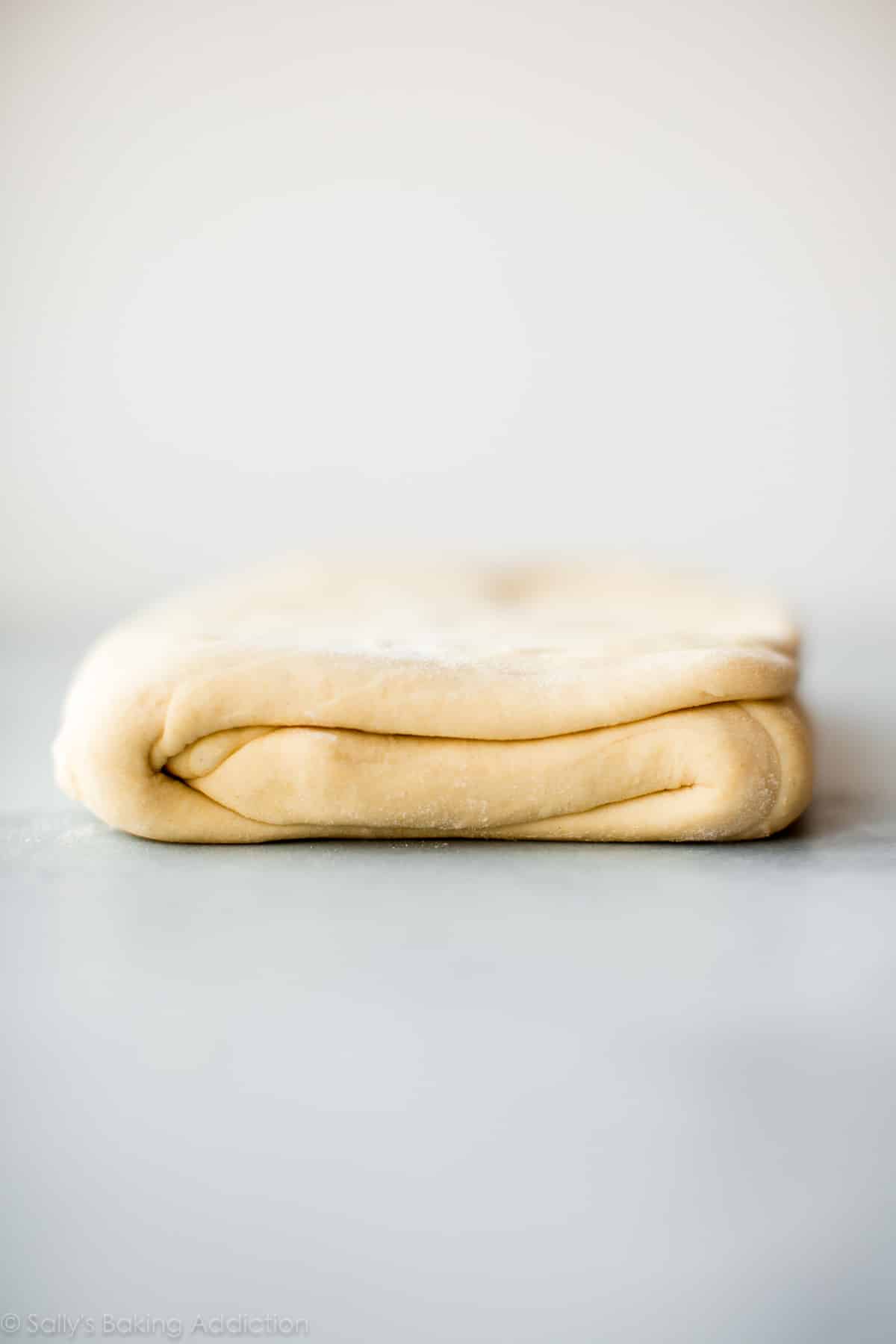
I’m not going into specifics today since I typed a novel about croissants the other week. Rather, we’ll focus our attention on rolling the croissants with chocolate. We’re starting with the same exact croissant dough. I talk about this a lot in the croissants recipe, but it’s worth repeating: croissant dough must remain cold and requires a lot of resting. Because of all that rest, there’s a time commitment to making this pastry. Which is why croissants are a delicious weekend project!
You’ll complete steps 1-12 in the original croissants recipe. Things change when it’s time to shape the dough. Once your dough has finished the 2nd 4 hour rest, roll and shape it into a long 8×20-inch rectangle. Use your pizza cutter and slice the rectangle down the center to create two 4×20-inch rectangles. Then slice across 3x to create eight 4×5-inch rectangles.
So far, this is exactly what you do when you make the original croissants.
Instead of slicing each of those rectangles diagonally into triangles, you’ll cut them in half to create 16 smaller rectangles.
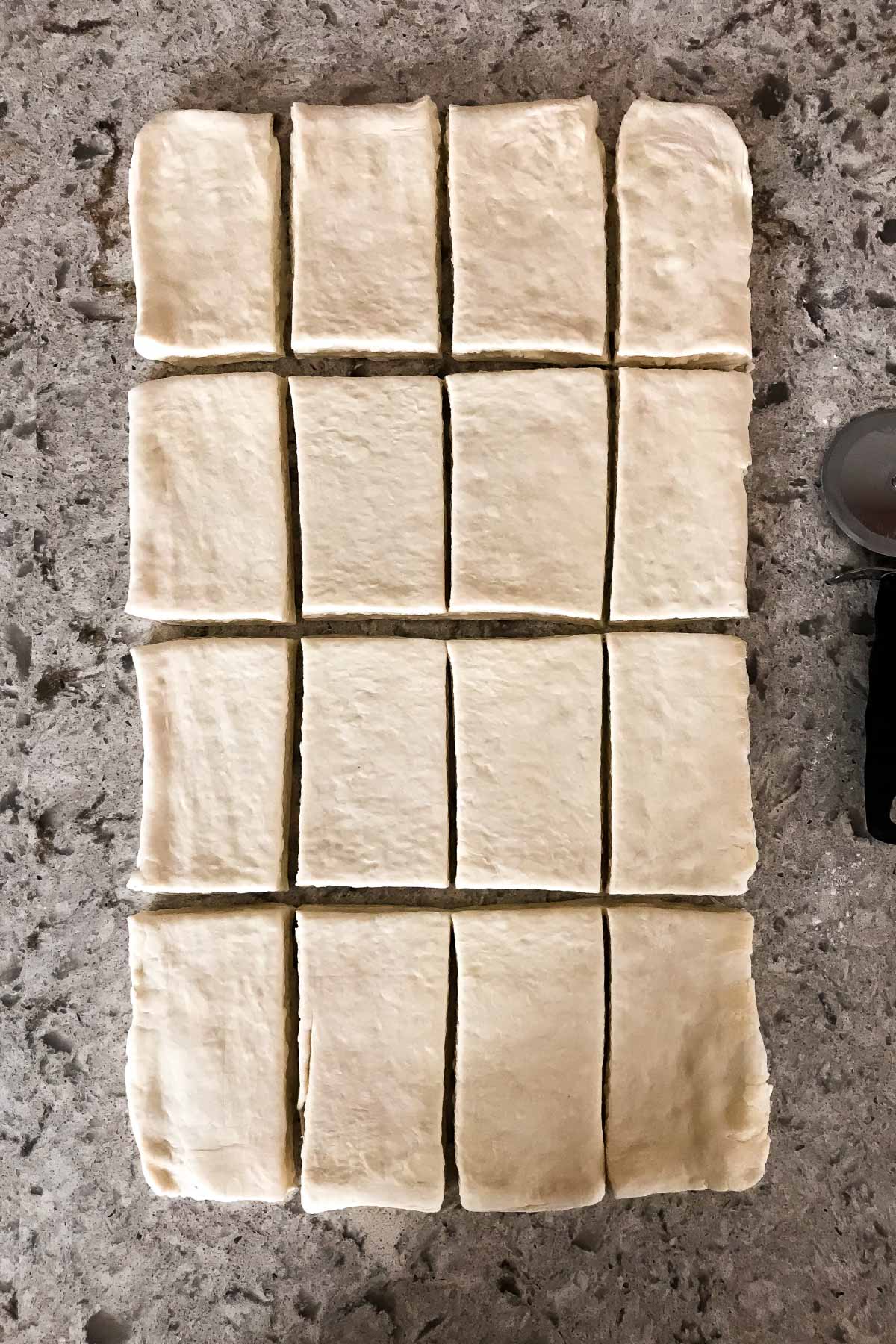
You could definitely keep the same triangle shape as we do with regular croissants, but the rectangle shape protects the chocolate from oozing out too much. And you can fit more chocolate inside. 🙂
Speaking of chocolate!
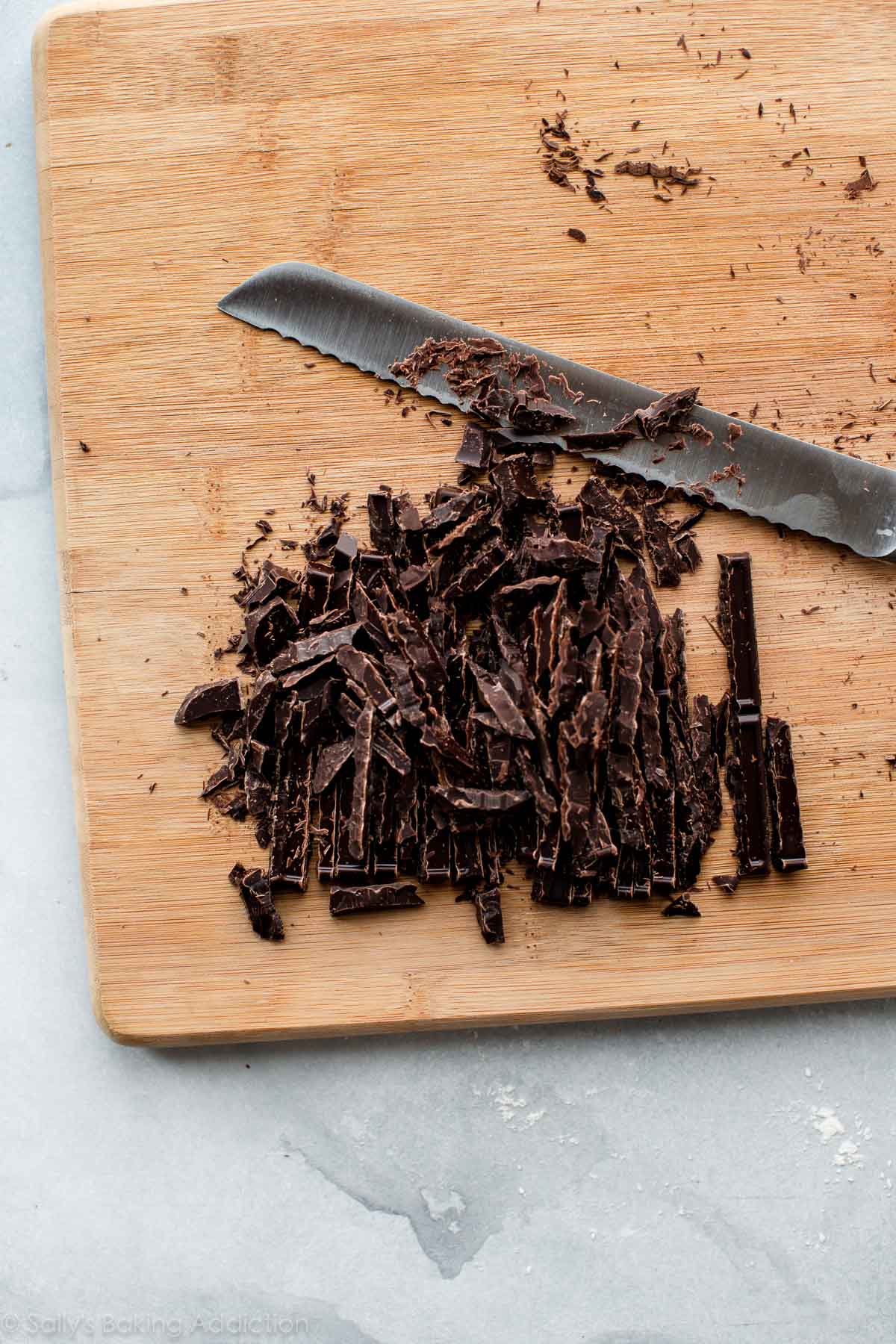
There are special conveniently sized chocolate batons you can purchase—just search the internet for chocolate batons—but I’d rather use the same chocolate I use for everything else: baking chocolate. I just buy it at the grocery store. You can use any brand of baking chocolate you like best, but I prefer the thinness of Ghirardelli’s baking bars. They slice thinly and neatly, fitting snug inside the croissant dough.
I like to use a darker chocolate like bittersweet or semi-sweet.
Now let’s roll up the chocolate croissants. Take each rectangle and gently stretch it out with your hands to be 8 inches long. Place a few pieces of chocolate at one end and roll it up tightly inside.
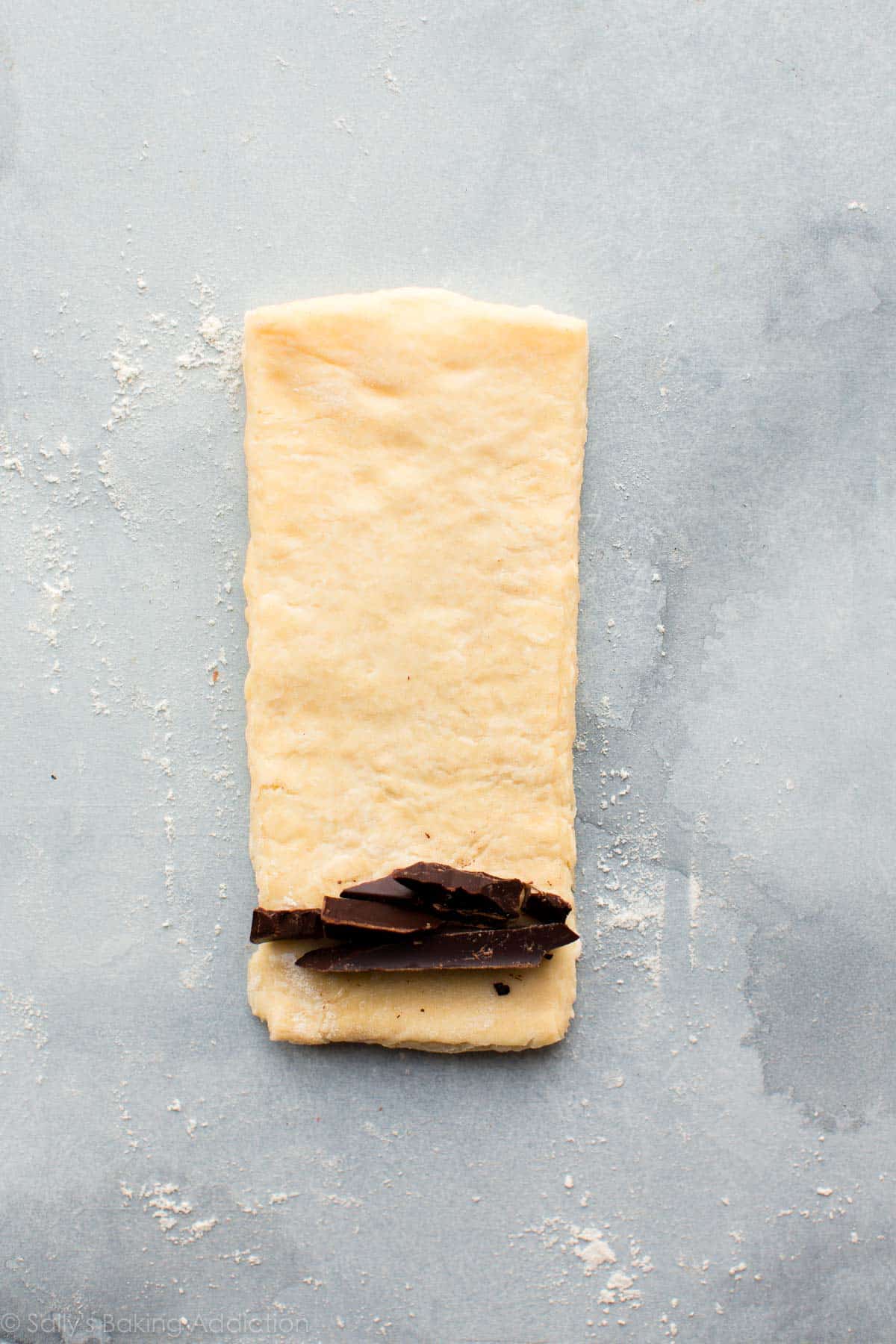
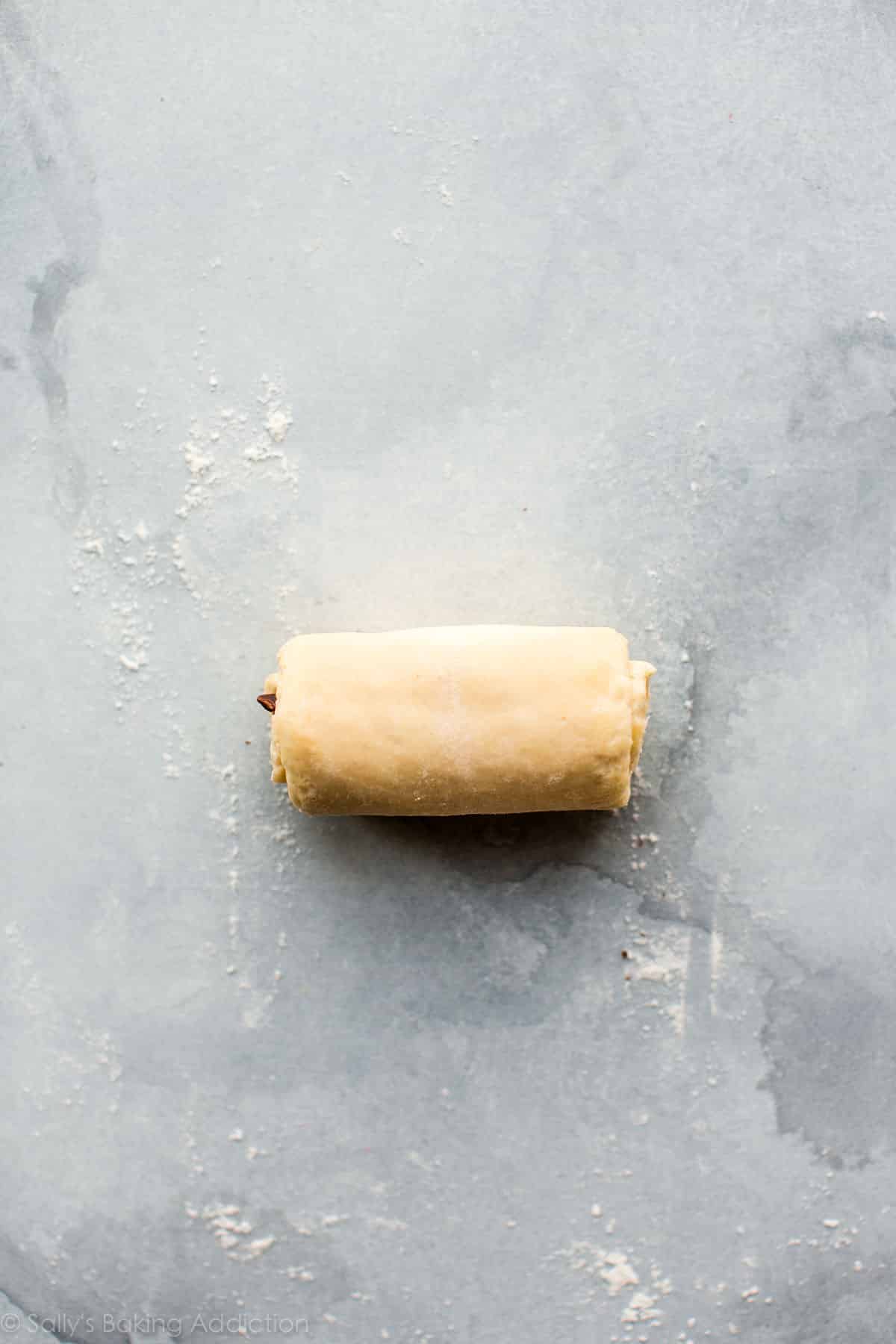
Like a little sleeping bag for chocolate!
We’re back to the original croissant recipe from here on out. Allow the shaped chocolate croissants to proof at room temperature for 1 hour, then continue in the refrigerator for another. I prefer the shaped chocolate croissants to be cold going in the oven because they won’t spread as much. The chocolate croissants will rise and proof at room temperature and continue to do so in the refrigerator.
After this time, they’ll be a little more puffy and ready to bake.
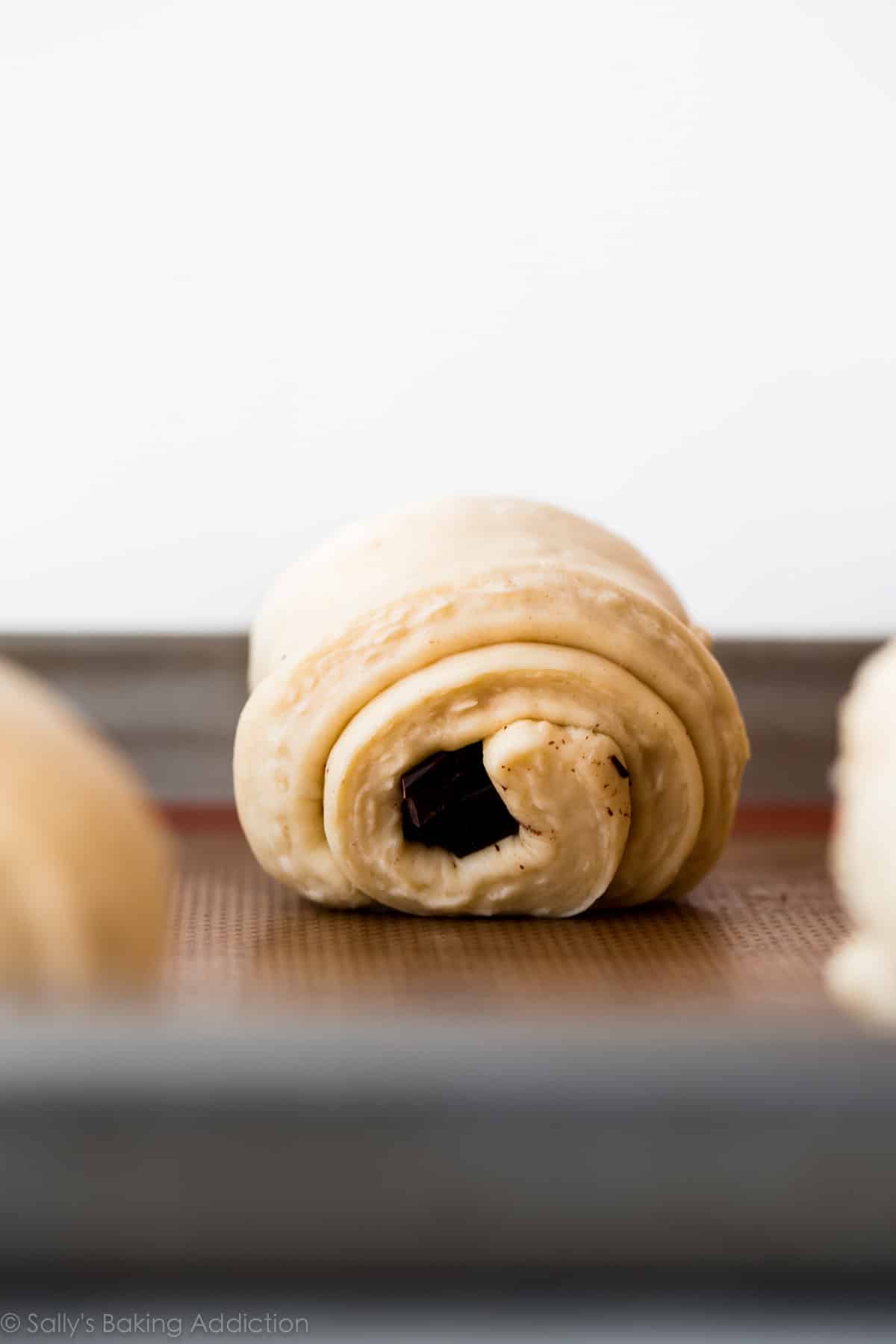
Brush them with an egg wash and 20 minutes later, you’ll understand the hype. Like I said before, there’s absolutely nothing better than a homemade fresh croissant filled with a river of melted chocolate. They’re golden brown with hundreds of crisp flaky layers (and that’s from a dough we laminated 3x!).
A snow shower of confectioners’ sugar is necessary.


Chocolate croissants, or pain au chocolat in French!
By the way, you can whip up this shortcut recipe in only 20 minutes. Or make a loaf of croissant bread with a bit shorter rest times and easier shaping.
Print
Homemade Chocolate Croissants (Pain au Chocolat)
- Prep Time: 12 hours, 45 minutes
- Cook Time: 20 minutes
- Total Time: 13 hours, 10 minutes
- Yield: 16 croissants
- Category: Pastries
- Method: Baking
- Cuisine: French
Description
Extra flaky and buttery homemade chocolate croissants (Pain au Chocolat) are incredible warm from the oven. Recreate this French bakery classic at home!
Ingredients
- 1/4 cup (4 Tbsp; 56g) unsalted butter, softened to room temperature
- 4 cups (500g) all-purpose flour (spooned & leveled), plus more for rolling/shaping
- 1/4 cup (50g) granulated sugar
- 2 teaspoons salt
- 1 Tablespoon active dry or instant yeast
- 1 and 1/2 cups (360ml) cold whole milk
- one 4-ounce bar (113g) semi-sweet or bittersweet chocolate, coarsely chopped
- optional: confectioners’ sugar for dusting
Butter Layer
- 1 and 1/2 cups (340g) unsalted butter, softened to room temperature
- 2 Tablespoons (16g) all-purpose flour
Egg Wash
- 1 large egg
- 2 Tablespoons (30ml) whole milk
Instructions
- Preliminary notes: I have lots of information to prepare you to make homemade chocolate croissants. A complete guide to making the croissant dough, with a video and step-by-step photographs, can be found in my original croissants recipe. That post will help you get through the first several steps. Additionally, you can see the post above for a visual for how the chocolate croissants are shaped, which begins in step 13 below. Make room in the refrigerator for a baking sheet. In step 6 and again in step 13, you will need room for 2 baking sheets.
- Make the dough: Cut the butter in four 1-Tablespoon slices and place in the bowl of an electric stand mixer fitted with the dough hook attachment (or you can use a handheld mixer or no mixer, but a stand mixer is ideal). Add the flour, sugar, salt, and yeast. Turn the mixer on low-medium speed to gently combine the ingredients for 1 minute. With the mixer running, slowly pour in the milk. Once all of the milk is added, turn the mixer up to medium speed and begin to knead the dough.
- Knead the dough: Keep the dough in the mixer and beat for an additional 5 full minutes, or knead by hand on a lightly floured surface for 5 full minutes. (If you’re new to bread-baking, my How to Knead Dough video tutorial can help here.) If the dough becomes too sticky during the kneading process, sprinkle 1 teaspoon of flour at a time on the dough or on the work surface/in the bowl to make a soft, slightly tacky dough. Do not add more flour than you need because you do not want a dry dough. After kneading, the dough should still feel a little soft. Poke it with your finger—if it slowly bounces back, your dough is ready to rest. You can also do a “windowpane test” to see if your dough has been kneaded long enough: tear off a small (roughly golfball-size) piece of dough and gently stretch it out until it’s thin enough for light to pass through it. Hold it up to a window or light. Does light pass through the stretched dough without the dough tearing first? If so, your dough has been kneaded long enough and is ready to rest. If not, keep kneading until it passes the windowpane test.
- Remove dough from the bowl and, with floured hands, work it into a ball. Place the dough on a lightly floured silicone baking mat lined, lightly floured parchment paper lined, or lightly floured baking sheet. (I recommend a silicone baking mat because you can roll the dough out in the next step directly on top and it won’t slide all over the counter.) Gently flatten the dough out, and cover with plastic wrap or aluminum foil. Place the entire baking sheet in the refrigerator and allow the covered dough to rest in the refrigerator for 30 minutes.
- Shape the dough: Remove the dough from the refrigerator. I like to keep the dough on the silicone baking mat when I’m rolling it in this step because the mat is nonstick and it’s a handy guide for the exact measurement. Begin flattening out the dough with your hands. You’re rolling it out into a rectangle in this step, so shaping it with your hands first helps the stretchy dough. Roll it into a 14×10-inch rectangle. The dough isn’t extremely cold after only 30 minutes in the refrigerator, so it will feel more like soft play-doh. Be precise with the measurement. The dough will want to be oval shaped, but keep working the edges with your hands and rolling pin until you have the correct size rectangle.
- Long rest: Place the rolled out dough back onto the baking sheet (this is why I prefer a silicone baking mat or parchment because you can easily transfer the dough). Cover the rolled out dough with plastic wrap or aluminum foil, place the entire baking sheet in the refrigerator and allow the covered dough to rest in the refrigerator for 4 hours or overnight. (Up to 24 hours is ok.)
- Butter layer (begin this 35 minutes before the next step so the butter can chill for 30 minutes): In a large bowl using a hand-held mixer or stand mixer fitted with a paddle or whisk attachment, beat the butter and flour together until smooth and combined. Transfer the mixture to a silicone baking mat lined or parchment paper lined baking sheet. (Silicone baking mat is preferred because you can easily peel the butter off in the next step.) Using a spoon or small spatula, smooth out into a 7×10-inch rectangle. Be as precise as you can with this measurement. Place the entire baking sheet in the refrigerator and chill the butter layer for 30 minutes. (No need to cover it for only 30 minutes.) You want the butter layer firm, but still pliable. If it gets too firm, let it sit out on the counter for a few minutes to gently soften. The more firm the butter layer is the more difficult it will be to laminate the dough in the next step.
- Laminate the dough: In this next step, you will be rolling out the dough into a large rectangle. Do this on a lightly floured counter instead of rolling out on your silicone baking mat. The counter is typically a little cooler (great for keeping the dough cold) and the silicone baking mat is smaller than the measurement you need. Remove both the dough and butter layers from the refrigerator. Place the butter layer in the center of the dough and fold each end of the dough over it. If the butter wasn’t an exact 7×10-inch rectangle, use a pizza cutter or sharp knife to even out the edges. Seal the dough edges over the butter layer as best you can with your fingers. On a lightly floured counter, roll the dough into a 10×20-inch rectangle. It’s best to roll back and forth with the shorter end of the dough facing you. Use your fingers if you need to. The dough is very cold, so it will take a lot of arm muscle to roll. Again, the dough will want to be oval shaped, but keep working it with your hands and rolling pin until you have the correct size rectangle. Fold the dough lengthwise into thirds as if you were folding a letter. This was the 1st turn.
- If the dough is now too warm to work with, place folded dough on the baking sheet, cover with plastic wrap or aluminum foil, and refrigerate for 30 minutes before the 2nd turn. I usually don’t have to.
- 2nd turn: Turn the dough so the short end is facing you. Roll the dough out once again into a 10×20-inch rectangle, then fold the dough lengthwise into thirds as if you were folding a letter. The dough must be refrigerated between the 2nd and 3rd turn because it has been worked with a lot by this point. Place the folded dough on the baking sheet, cover with plastic wrap or aluminum foil, and refrigerate for 30 minutes before the 3rd turn.
- 3rd turn: Roll the dough out once again into a 10×20-inch rectangle. Fold the dough lengthwise into thirds as if you were folding a letter.
- Long rest: Place the folded dough on the lined baking sheet, cover with plastic wrap or aluminum foil, and refrigerate for 4 hours or overnight. (Up to 24 hours is ok.)
- At the end of the next step, you’ll need 2 baking sheets lined with silicone baking mats or parchment paper. The dough is currently on a lined baking sheet in the refrigerator, so you already have 1 prepared!
- Shape the croissants: Remove the dough from the refrigerator. On a lightly floured counter, roll the dough out into an 8×20-inch rectangle. Use your fingers if you need to. Once again, the dough is very cold, so it will take a lot of arm muscle to roll. The dough will want to be oval shaped, but keep working it with your hands and rolling pin until you have the correct size rectangle. Using a pizza cutter or sharp knife, slice the dough in half vertically. Each skinny rectangle will be 4 inches wide. Then cut 3 even slices horizontally, yielding 8 4×5-inch rectangles. See photo above for a visual. Cut each rectangle in half lengthwise so you have 16 2×5-inch rectangles. Work with one rectangle at a time. Using your fingers or a rolling pin, stretch it to be about 8 inches long. Do this gently as you do not want to flatten the layers. Place a few small pieces of chocolate in a single layer at one end and tightly roll the dough up around the chocolate. Make sure the end is on the bottom. Repeat with remaining dough, placing the shaped croissants on 2 lined baking sheets, 8 per sheet. Loosely cover with plastic wrap or aluminum foil and allow to rest at room temperature (no warmer! I suggest just keeping on the counter) for 1 hour, then place in the refrigerator to rest for 1 hour or up to 12 hours. (Or freeze, see freezing instructions. I prefer the shaped croissants to be cold going into the oven.
- Preheat oven to 400°F (204°C).
- Egg wash: Whisk the egg wash ingredients together. Remove the croissants from the refrigerator. Brush each lightly with egg wash.
- Bake the croissants: Bake until croissants are golden brown, about 20 minutes. Rotate the pans halfway through baking. If croissants show signs of darkening too quickly, reduce the oven to 375°F (190°C).
- Remove chocolate croissants from the oven and place on a wire rack to cool for a few minutes before serving. They will slightly deflate as they cool. If desired, dust with confectioners’ sugar before serving.
- Croissants taste best the same day they’re baked. Cover any leftover croissants and store at room temperature for a few days or in the refrigerator for up to 1 week. You can also freeze for up to 3 months, then thaw on the counter or overnight in the refrigerator. Warm up to your liking.
Notes
- Make Ahead Instructions: Croissants are perfect for getting started ahead of time. The dough can rest for 4 hours or overnight in step 5 and again in step 11. You can also freeze the dough after the 3rd turn in the lamination process (after step 10). Instead of the 4 hour rest in the refrigerator in step 11, wrap the dough tightly in plastic wrap or aluminum foil, place in a freezer zipped-top bag, and freeze for up to 3 months. Thaw in the refrigerator and continue with step 12. You can also freeze the shaped croissants after they rest for 1 hour at room temperature in step 13. (Before placing in the refrigerator.) Cover them tightly and freeze for up to 1 month. Thaw completely in the refrigerator, then bake as directed.
- Special Tools (affiliate links): Electric Stand Mixer | Rolling Pin | Pizza Cutter | Pastry Brush | Silicone Baking Mat | Baking Sheet
- Yeast: I use and recommend Red Star Platinum, an instant yeast. Reference my Baking with Yeast Guide for answers to common yeast FAQs.
- Chocolate: You can find 4 ounce chocolate baking bars in the baking aisle. I recommend using Ghirardelli brand because the bars are thin and the thin pieces roll up neatly in the croissant dough. I use bittersweet chocolate, but you can use milk chocolate, semi-sweet, or darker chocolate.
- Keep Dough Cold: Make sure the dough is ALWAYS cold. If it warms up too much, stop what you’re doing and place the dough back in the refrigerator for 20 minutes.
- Floured Surface: Lightly flour the work surface, your hands, the dough, and the rolling pin as you work.
- Air Bubbles: If there are air bubbles in your dough, pop them with your fingers or a toothpick, then lightly flour where you popped the air bubble.
- Croissants for Brunch: I recommend starting the recipe the day before in the early afternoon. Complete steps 1-10, then let the laminated dough have a long rest in the refrigerator overnight (step 11). Begin step 13 2-3 hours before brunch.
- Dough adapted from Joy of Baking, Fine Cooking, and Epicurious



















I loved the plain croissants recipe and I am keen to try this one. Can I use almond paste to make these almond croissants instead? Almond croissants are my favorite. Please advise 🙂
Hi Pooja, I’m so happy you enjoyed our classic croissants recipe! We haven’t tested a recipe with almond paste quite yet- let us know if you do!
Thank you for the response! Do you think it would be 1:1 substitute of chocolate to almond paste and I can use the same base recipe for the dough?
I tried making almond croissants using homemade fangipane, but it seeped out during baking. But after further research, my next attempt was going to be with homemade almond paste, but then warm/humid summer wheat her hit. I hope to give it a try this winter.
I’ve been looking to see if anyone asked this question because I’m interested in trying the croissants with almond paste. I’m going to give it a try.
I guess I didn’t cool the croissants long enough before baking but in the oven the butter melted all over the baking sheet and made the bottom of the croissants greasy and soggy. But they still tasted awesome. This recipe did take a long time with all the time in the fridge but definitely worth it. I had no idea you could make croissants at home so easily.
Mine was underbaked for some reason. I followed the recipe. The taste was good but it was underbaked and when I baked it longer the croissants became tough.
I absolutely love your recipes and this one is a particular hit in our house. I do have trouble with the initial mixing – my dough never pulls away from the mixing bowl and is very sticky. I’ve tried both spooning/leveling with a measuring cup and weighing. I end up adding more flour while mixing but sometimes the final product is not as light. Any suggestions?
Hi Tate, There are a lot of variances that go into the consistency of dough, even down to the weather and humidity in the air. If you find that the dough is overly sticky and is tearing as you work with it, sprinkle more and more flour on it as you shape it and roll it out. Keep the dough as cold as possible, even if that means stopping during any point and refrigerating it for 15-20 minutes before continuing.
I made these for my family for breakfast! It was a delicious treat. We like the ones from Panera and I thought I’d try to make some. So good fresh! I will definitely make them again. I wish I would have made the final squares thinner but I learned a lot!
I’ve made croussants with bar chocolate, but it hardens to chocolate-chip density of the croissants aren’t eaten right away. I’m going to try a firm ganache instead, to assure chocolate just soft enough if these don’t get gobbled up right out of the oven.
I have a tip for you Sam! Get the chocolate batons that are made specifically for chocolate croissants. Chocolate with higher cocoa butter percentage melts and spreads faster than chocolate with lower cocoa butter percentage. The chocolate batons are made specifically for this purpose, so give them a try! Otherwise test chocolates that have lower cocoa butter percentages. Hope this helps!
Made these last weekend to challenge myself and they turned out amazing! I used a German chocolate baking bar, but otherwise did everything as listed great instructions and easy to follow! Thank you!
Dear Sally, I really love this recipe and your website. But there is one thing that is not comfortable for readers outside the U.S. – before baking, we have to figure out, how much centimeters will be 8 / 12 / 40 inches, etc. Is it possible to add measurements in centimeters in future recipes? It would be extremely useful for many readers.
Again, thank you for sharing your recipes!
Love the recipe and instructions.
I’m traveling to my daughter’s home, 4 hours away. How do you think they’ll fare if I prepare to the last stage, refrigerate them there Friday night, and bake Saturday morning?
These croissants have never failed me!!! They have always been incredible and fairly easy! However, I’m having a problem now that we moved back to the south?! My dough just seemed so sticky… and my lamination had my butter spreading everywhere and constantly sticking to my granite. Any tips on what is happening? I had these nailed down in the desert ♀️ I stuck with this batch so we’ll see how they bake, but they were SUCH a pain!!
Hi Kirstyn, I’m guessing you moved to a more humid environment?! This happens here when baking these on a humid day! Don’t be scared to sprinkle more and more flour on it as you shape it and roll it out. Keep the dough as cold as possible, even if that means stopping during any point and refrigerating it for 15-20 minutes before continuing.
Croissants have always been a little intimidating, but this recipe was pretty straight forward. I’ll definitely make these again, but will double the chocolate and might make them a tad wider. I enjoyed making them and they turned out well. Thanks!
Love the easy to use steps and video!
Can I roll and shape the croissants the night before and bake in the morning?
I’ve been looking for a US comparable pastry from my time spent in Europe for some time. So my 3 year old and I attempted this recipe for the first time this weekend. I was so nervous with all the steps that we would miss something (being 9 months pregnant too). But everything turned out wonderfully. Thanks for the step by step instructions, it was also helpful to read the comments in advance to help avoid mistakes and answer my questions.
Turned out amazing!! Thanks for the detailed explanation
This recipe is fantastic! Thanks for all of your tips. Question-if I want to increase the size of each croissant, perhaps in step 13, keeping them as 8 (4×5) rectangles, what would the baking time adjustment be? Or how do I calculate the additional time? I baked at 375.
Hi Lisa, so glad you enjoy these! I can’t say what the exact bake time would be for sure, but you can determine their doneness– once golden brown all over, they’re all set.
Hi Sally! Thank you for making this detailed recipe I am excited to try it! I was just wondering if I would need to change the measurements that I rolled the dough into in steps 4 and 13 if I wanted to half the recipe and make only 8 croissants.
Hi Serenity, If you cut the recipe in half then yes, your rectangles will be half the size. This will yield 8 of the same size croissants.
Hi Sally, this recipe looks perfect.. loved watching the video and now soo badly want to make this.. though I was thinking if I can half the ingredients as this is going to be my first time and if I fail I don’t want everything to go waste.. would you please help me provide recipe to make small batches so that I practice before I get it right?
Thanks
Nive
Hi Niveditha, thank you! For best success, I highly recommend making the recipe as written and freezing the extra croissants. (Always nice to have some on hand!) If you really want to halve the recipe, the dimensions should be halved too.
My family ate these up in one day! I especially appreciated your Baking with Yeast guide! (not pre-dissolving my active dry yeast was definitely the right choice)
I am curious though why you choose to blend a bit of flour with your butter for the laminating steps? Does it serve a purpose? Half the recipes I considered just used butter without the extra flour.
Hi Lauren, Beating the butter with flour gives it some stability. I explain it in detail in my original croissant recipe if you wish to read more about it!
This recipe is AMAZING. I watched the video on the plain croissants page several times, then just followed step by step. They are so light, flaky and DELICIOUS! Thank you for the absolutely impeccable and helpful instruction. You’re a great teacher and your recipe is amazing.
Hi Sally,
I just made the dough and it’s in the fridge after it’s third laminating process. Like many other people, I seem to have used butter that was too cold and it is definitely poking through. Is there any way to save it at this point? If I left it out and let the butter soften and then tried another lamination, could that do the trick? I hope it’s not too late to save my croissants. Let me know what you think. Thanks so much!
Hi Jess, let the butter soften inside the dough at room temperature. Once it’s softer, continue with the folding. It’s not too late to save them, I promise. Even with cold chunkier pieces of butter in my dough, the croissants still come out, they just leak a little more butter.
They ended up fine! Next time I’m definitely going to try and chill them more between each turn…even more than the recipe said. But they were still really good with quality laminations!
Flour question? I am unsure what brand of AP flour you use, but I use King Arthur. King Arthur weighs 120 grams per cup, which means 4 cups equals 480 grams. Should I use 480 grams or the 500 grams called for in your recipe? I have been converting recipe ingredients to grams for years, as most give them in cups. I calculate based on each brand of ingredient. King Arthur flour for instance, has more protein then most flours, so one can use less. However I am always unsure when recipes do give grams, and they are different then my calculations.
Hi Kristin! I use King Arthur Flour as well. I get anywhere between 120-125g per cup when I measure and test recipes. With this much flour, 20g doesn’t make a huge difference. Still, I would use 500g.
These turned out perfectly!! The perfect quarantine project. I do not have any of the proper tools aside from a food processor with a dough setting and they turned out amazing! I used an unopened bottle of wine wrapped in plastic wrap for a rolling pin I wish I could attach my photo! Thank you so much for sharing. The videos made it all so accessible, and the process made me appreciate every croissant I was ever able to just go to a coffee shop to get.
Hi! I had so much fun making these, even though they didn’t turn out. Do you think you could help me figure out why? Like someone else commented, the butter melted out as they baked. But I noticed when I was doing the laminating and rolling process that I could see chunks of broken up butter in the dough. I only put the butter in the refrigerator for 30 minutes, so it doesn’t seem like it would be too hard. Any suggestions? Thanks! It was a fun recipe to try!!
Hi Kellynne! I’m so glad you enjoyed making these chocolate croissants. I’m glad to help for next time though. Chunks of hardened butter in the dough is typically laminating with butter that is too cold. It breaks and rips the dough. Make sure your butter is soft– basically the dough and butter should always be near the same texture and temperature. If at any point in the shaping/folding steps the butter is hard underneath the layers of dough, let the dough sit at room temperature until the butter has softened.
I never thought I would have been able to bake croissant myself, but I did it! Thank, Sally, for this recipe, the detailed tutorial, video and troubleshooting notes. They all have been very helpful to me! I had air bubbles, butter sometimes breaching during lamination – but I floured the spots and that did the trick. The only thing I couldn’t solve was the butter leakage during baking, which resulted in the bottom a bit overbaked. Other than that, they were amazing: buttery and flaky, with delicious layers… my hubby said they were competitive with those from our favorite bakery, and my friends – when they got the pictures I sent them – couldn’t believe they were homemade!
i have always wanted to try making croissant. i successfully followed the recipe and was delighted with 16 beautiful, delicious croissant. fresh out of the oven these were the best things i have tasted in a long time. thank you for your great recipe and directions. they came out perfectly – and were heavenly!
Wow, I can’t believe I made chocolate croissants. They were delicious, flaky and my hardwork paid off because my husband loved it. It his favorite by the way. I made some mistake but still came out perfect. Thank you for posting this recipe , I’m always afraid that I can’t make this kind of pastry. I made the no knead cranberry and walnut at the same day. It was all day kind a project. Thanks again Sally, you’re the best!!!!
Any chance you can use salted butter instead?
Hi Lindsey, I recommend unsalted butter, but if you use salted butter, I recommend reducing the salt in the dough to 1 and 1/4 teaspoons.
Hi Sally,
I’ve made the plain croissants twice now and I’m now a croissant junkie! I can across a recipe for orange-sage croissants in our local paper, and in the butter that gets folded in is where orange zest and 1/2 tsp of sage is added. Do you have any experience with adding flavors to the butter. I’m going to try it and add orange zest (and maybe a drop or two of extract) in the butter when I try my choc croissants. I’m also going to use some of the Lindt Intense Orange with some of the dark (85%) choc for the inside. What are you thoughts? I’d like to make rosemary flavored (a savory) croissant by adding powered rosemary to the butter. My question is how much to use? Have you ever tried anything like that. Thanks! And thanks for making your recipes so easy to understand.
Sounds delicious! I haven’t tried it, but let me know if you do.
I will bake mine in the tomorrow . So excited! I only have the last step to roll and shape left. But by the time I do that and let them sit out and back in the fridge it will be late morning. I am wondering if you can freeze these after they are shaped. This makes too many for my husband and I to eat so will be sharing with friends but would love to have some on hand to be able to eat with my morning latte. I have had William Sonoma croissants that were frozen. I put them on the pan before I went to bed and they were ready to bake in the morning. IS that a possibility for these?
I can’t see why not! Best way is to freeze after the chocolate croissants are shaped and bake from frozen for a few extra minutes.
Hello Sally! I have made your regular croissants and I loved them and decided I wanted to mix things up and try the chocolate. I only have baking chocolate in the form of wafers/chips. Do you think those will be okay? Should I chop them up?
I’m so glad you enjoyed the croissants, Emmie! You can chop the wafers if they are particularly large but it’s not necessary if they are small enough to roll inside the dough.